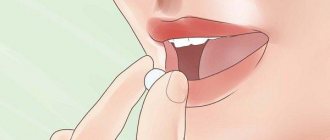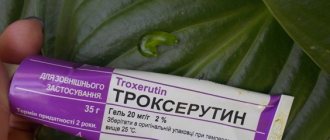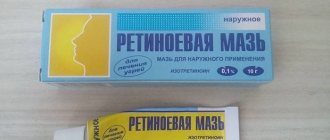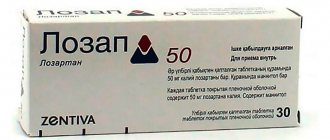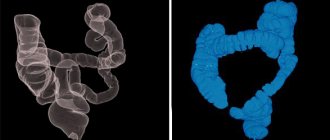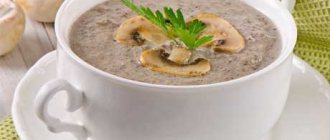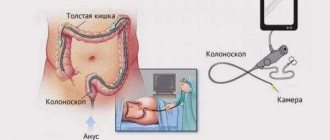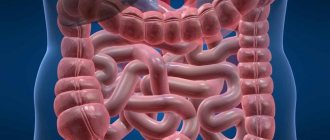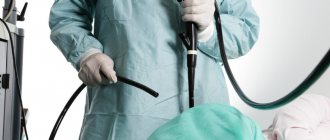Indications for the procedure
Irrigoscopy is a medical examination that provides X-ray images of the intestines (large intestine). This method is safe and helps to identify many diseases of the colon (cancer, polyps, inflammation, ulcers and others).
Indications for contacting a specialist are:
discomfort in the anus, bleeding; diarrhea or constipation; discharge of any nature from the anus (pus, mucus, etc.); suspected tumors; colitis; ulcer; intestinal inflammation; diverticula; other problems, unpleasant or painful sensations in the intestines or anus.
Progress of irrigoscopy
If the patient follows the preparation tactics, the intestines are completely cleansed, and the procedure does not take much time. It is carried out on a special table in the X-ray room, and consists of the following stages.
- Sigmoidoscopy to examine the condition of the rectum.
- The patient is placed on an inclined table in the Simps position.
- A flexible tube is inserted into the anus.
- Under continuous X-ray control, a pre-calculated amount of barium suspension is injected into the intestine, acting as a contrast agent.
- At this time, the patient is warned about possible discomfort and the urge to defecate - calm, deep breathing through the mouth usually eliminates this problem.
- After administering the solution, the patient needs to turn from side to side several times to evenly distribute the contrast.
- An overview photograph is taken.
- The patient goes to the toilet to have a bowel movement.
- After this, a repeat photo is taken.
Double contrast (horizontal patient position)
If irrigoscopy with double contrast was prescribed, then in addition to the barium suspension, air is pumped into the intestine - the Bobrov apparatus is used. Stretching the intestine allows you to study its relief in more detail, which is important when diagnosing diverticula, tumors, polyps - they may not be noticed with standard contrast.
There are practically no complications with such a study. It is extremely rare to experience allergic reactions to the contrast agent. All unpleasant sensations associated with the introduction of large amounts of liquid and air into the intestines, as a rule, completely disappear the next day. A gradual return to normal eating is recommended.
Preparation for intestinal irrigoscopy
The day before the procedure, the patient should completely abstain from any food. During the day, he needs to drink clean water, without gas (drinks such as juices, tea, coffee are prohibited). The amount of water you drink per day should be from 2 to 3 liters. A diet through fasting during the day is not only necessary for good visibility during the procedure, but it is also beneficial for the body as a whole.
It should also be remembered that the more responsible the patient is in preparing for irrigoscopy, the more accurate and correct the diagnosis will be made by the doctor.
Price positions of funds
Due to the fact that the drugs are produced mainly abroad, the cost of laxatives for study preparation is quite high. You can buy picoprep for around 700 rubles for 2 ampoules, fortrans - up to 600 rubles for a pack of 4 bags, 4 tubes of microlax - about 350 rubles. Duphalac bottles, depending on the volume (0.2, 0.5 and 1.0 l) cost from 300 to 750 rubles. The Russian manufacturer produces Lavacol, a cheap generic version of Fortrans (200 rubles for 15 sachets).
Bowel cleansing before irrigoscopy
Many people cleanse the intestines on their own, but they must understand that this is a very responsible procedure.
There are several ways to cleanse the colon. Here are some of them:
preparation for intestinal irrigoscopy with enemas
This is the most common way. To do this, you will need an enema (Esmarch mug) and warm water. Cleansing should begin 5-6 hours before the procedure. If irrigoscopy is scheduled for the morning, then the enema should be done in the evening of the previous day. For an enema, you need water that is not too warm (35-37 ºС). If the water temperature is higher, then all the feces will dissolve and it will be difficult to remove them from the body. Fill Esmarch's mug with water. The tip of the tube can be lubricated with petroleum jelly or cream for easy insertion. Gently insert the tube into the anus and open the valve to allow water to flow into the intestines. The first filling should start with 1.5 - 2 liters of water. After introducing water into the intestines, you need to lie on one side for 5-7 minutes, with your legs tucked under you, and then roll over to the other side. The procedure should be carried out until the water becomes clear at the outlet. Instead of pure water, you can use water with the addition of a solution of herbs (chamomile). When an enema is contraindicated (hemorrhoids, intestinal inflammation, etc.), other methods of colon cleansing should be used;
preparation for intestinal irrigoscopy with Fortrans
Fortrans is a medical product, white powder intended to cleanse the intestines. It contains substances such as macrogol, anhydrous sodium sulfate, sodium bicarbonate, sodium and potassium chloride. All these substances can cleanse the intestines. First, you should calculate how much Fortrans you need to take (more about this here and here), since the amount depends on your body weight. Divide your weight by 25 and get the required number of sachets of the drug. Next, prepare a solution at the rate of 1 sachet per 1 liter of water. The resulting solution is drunk according to the following scheme: 1 glass every 15 minutes. Fortrans has an unpleasant taste, so you can add lemon or orange juice. Contraindications: age under 15 years, intestinal perforation;
preparation for intestinal irrigoscopy with Duphalac
Duphalac is a good laxative, available in liquid form. To take it, you need to dilute the entire composition of the bottle (200 ml) in water (2-3 liters). You need to drink the solution over 2-3 hours, not all at once. Approximately drink a glass of solution every 15-20 minutes. Bowel movements begin within 1-2 hours after the first dose. Cleansing with Duphalac is comfortable and gentle;
preparation for intestinal irrigoscopy with flit
A fairly simple procedure, which is carried out the day before irrigoscopy. For complete cleansing, you will need 2-3 sachets of flit (1 sachet – 45 mg). In the morning, after a light breakfast or without it, dilute 1 sachet of the substance in half a glass of cool water and drink the whole thing, do not divide into several doses. The same procedure is carried out in the evening after dinner or before bed. If irrigoscopy is not scheduled for the morning, then you should drink another sachet.
preparation for intestinal irrigoscopy with magnesium
Preparation with magnesium is carried out 3-4 days before irrigoscopy, since magnesia has a strong laxative effect, the effect of which does not stop the next day after administration. 20-30 g of magnesia powder is diluted with water, an emulsion is formed, which you need to drink. The urge to defecate begins within 1 hour. Repeat the procedure in the evening.
When cleansing the intestines on your own, you should be careful, carefully read the instructions and take into account all contraindications.
For consultation and selection of a clinic, you can use the services of the site: to independently select a doctor (form on the left), a form for searching and selecting the doctor you need (fill out above the article), or you can select a clinic for consultation and undergoing the procedure (list below the article). Be healthy and do not self-medicate!
Irrigoscopy requires special training, the quality of which affects the information content and accuracy of the results of the diagnostic procedure. Preparation for irrigoscopy begins 2 days before the scheduled date of the study. First of all, you need to go on a slag-free diet, that is, exclude from your diet all foods that contribute to the formation of a large amount of feces and provoke severe gas formation. For two days before the diagnostic procedure, it is mandatory to follow a slag-free diet. That is, it is necessary that the colon is free of feces that will interfere with the study.
Foods that cause increased gas formation and heavy stool include greens, almost all vegetables (potatoes, tomatoes, beets, carrots, onions, peppers, cabbage, etc.), berries and fruits (apricot, peach, apple, citrus, bananas, etc.), pearl barley, oatmeal and millet porridge, mushrooms, wholemeal bread, bran, and legumes (beans, peas, beans, lentils, etc.). These slag products must be excluded from the diet 2–3 days before the date of irrigoscopy. During these 2 - 3 days before irrigoscopy, you should eat only slag-free foods that do not cause heavy stool. It is allowed to eat broths, semolina porridge, eggs, boiled lean meat and fish, cheese, butter, and fermented milk products with the exception of cottage cheese. It is recommended to boil or steam all products. The broth should be weak, not strong and not rich.
On the day before irrigoscopy, you should eat only light meals for lunch, for example, boiled fish, semolina porridge and fermented milk products. And for dinner you need to be content with exclusively liquid food - broth, yogurt, compote, etc. Breakfast on the day of irrigoscopy should also consist only of liquid dishes - broth, fermented milk drinks, compotes, etc.
In addition to following a slag-free diet, before irrigoscopy it is necessary to thoroughly cleanse the intestines using enemas or special laxative medications.
If bowel cleansing is performed using enemas, then they must be carried out strictly at certain hours. Firstly, on the day before irrigoscopy at lunch (approximately 14-00 - 15-00), you should take 2 tablespoons of castor oil or 150 ml of a 30% solution of magnesium sulfate (MgSO4), which help to completely cleanse the colon of feces. Then, on the evening before the study, after self-defecation, be sure to do two enemas with an interval of two hours between them. It is best to do an enema at 20-00 and at 22-00. On the morning of the examination, an enema is performed again at 7–8 am. In this case, enemas are done in the morning until the rinsing waters become clear. At one time, 1–2 liters of warm, salted or acidified boiled water is injected into the intestine.
Cleansing the intestines with the help of special natural and mild laxatives is more comfortable for a person compared to enemas. Currently, laxatives based on macrogol (Fortrans, Tranzipeg, etc.) or lactulose (Duphalac, etc.) are used to prepare for irrigoscopy.
Fortrans for bowel cleansing before irrigoscopy can be used according to the following two schemes:
1.
On the day of the study, dilute the required amount of granules (for a body weight of less than 50 kg, take 2 sachets, for a body weight of 50-80 kg - 3 sachets, over 80 kg - 4 sachets) in warm boiled water. In this case, dilution is carried out in accordance with the ratio: take 1 liter of water for 1 sachet of Fortrans. The finished solution is drunk completely in the morning before irrigoscopy for several hours - best from 5-00 - 6-00 to 10-00. It is recommended to drink one glass of the solution every 15 to 20 minutes. Stool begins to be released 1 - 1.5 hours after starting to take Fortrans. Stool production ends 2 to 3 hours after taking the last dosage of the laxative. 4 hours after taking the last dose of the drug, irrigoscopy can be performed.
2.
On the day before irrigoscopy, before 12-00, you can have breakfast with yogurt, eggs or semolina porridge. After 12-00 hours it is necessary to consume exclusively liquid food - broth, tea, compote, mineral water. Dilute the required amount of Fortrans (for a body weight of less than 50 kg, take 2 sachets, for a body weight of 50 - 80 kg - 3 sachets, over 80 kg - 4 sachets) in warm water. In this case, you need to take 1 liter of water per 1 bag of granules. The entire prepared solution must be drunk on the day before irrigoscopy from 17-00 to 21-00 in the evening. It is recommended to drink the solution one glass every 15 – 20 minutes. Remember that stool will stop coming out 3 hours after taking the last dose of Fortrans. Therefore, when taking the last glass of the drug solution at 21-00, stool will stop being released at 00-00 hours. On the morning of the day of irrigoscopy, from 7-00 to 9-00 in the morning, drink another 1 liter of Fortrans solution (to prepare it, 1 sachet is diluted in 1 liter of water). 2 hours after taking the last dose of the solution, stool stops, and irrigoscopy can be performed only after 4 hours.
In addition to Fortrans, Duphalac, Lavacol and other laxatives containing lactulose and macrogol as active substances can be used to cleanse the intestines. These drugs must be used in accordance with the instructions for use, which, in most cases, are similar to those for Fortrans. The only difference will be the ratio of the amount of drug and water for preparing the solution.
Preparation for irrigoscopy consists of following a diet and cleansing the intestines with enemas or laxatives. In addition, it is necessary to avoid taking any medications 2–3 days before the study.
Preparation for irrigoscopy involves a special diet, as well as bowel cleansing, which affects the reliability of the results obtained.
Fluoroscopic visualization is only possible with complete bowel cleansing. Food debris interferes with contrast filling and can distort the result. If the lumen of the colon is filled with feces, the procedure will have to be postponed.
Preparation for irrigoscopy consists of two stages.
Special diet. Helps remove toxins and excess fluid, normalize stool. Purgation. The lumen is freed from the remains of feces and mucus.
The complete absence of contents throughout the entire colon is considered excellent preparation. A small amount of clear mucus is acceptable. In 30% of cases, insufficient cleaning is the cause of incomplete irrigoscopy.
The patient should warn the doctor if he is taking non-steroidal anti-inflammatory drugs or blood thinners. Although slightly, they increase the risk of bleeding. It is recommended to abandon them within 7-10 days. You may need to stop taking vitamins containing iron and medications to lower your glucose levels.
Diet menu for 3 days
A sample menu looks like this, although you can add to it or change items as you wish.
The first day
We have breakfast: buckwheat porridge, a soft-boiled egg or an omelet from 1 egg, a piece, no more than half, of banana, coffee and a small piece of toast with butter.
We have lunch: liquid soup with a piece of meat, cottage cheese, a bun with jelly.
We have dinner: pasta with a boiled piece of meat, boiled beet salad, sweet weak tea with biscuits or any Lenten cookies.
Second day
We have breakfast: rice porridge, steamed omelette, applesauce from a boiled apple without peel and core, coffee and a sandwich with low-fat cheese.
We have lunch: soup in vegetable or meat broth with the addition of rice or semolina, a piece of white bread, a bun with low-fat kefir.
We have dinner: pasta with boiled low-fat fish, cottage cheese casserole and compote with crackers.
The third day
We have breakfast: semolina porridge and steamed omelet, coffee and a sandwich with a little butter;
We have lunch: light soup, boiled fish or chicken, a glass of low-fat kefir and cookies.
We have dinner: light broth and green tea.
As you can see, the last meal on the eve of the procedure involves taking only liquid food. Eating solid food should be stopped after lunch at approximately 14:00.
We remind you that at 15:00 you should take 2-3 tablespoons of castor oil. And after it takes effect and the intestines are emptied, begin cleansing measures.
Whether you do this using enemas or modern laxatives depends on the doctor's decision, your personal preferences and your health.
Slag-free diet
Two days before irrigoscopy, you must switch to a slag-free diet. If you have constipation, you need to follow a diet for four days before the examination.
You will have to exclude from the diet:
black bread made from wholemeal flour, confectionery; whole milk, cottage cheese; carbonated drinks, kvass; legumes, potatoes, pasta; oatmeal, wheat, pearl barley; fatty meat and fish; seasonings, spices; fruits and vegetables high in fiber (cabbage, apple); coffee, black tea, chocolate, nuts.
Vegetables and cereals retain more nutrients if they are subjected to minimal heat treatment. It is advisable to soak the cereal in water for several hours, then cook for 5-7 minutes and wrap in a towel for 10-20 minutes.
Fish and meat should be boiled or steamed. Fish and meat dishes are recommended to be eaten with vegetable salads.
Prohibited Products
It is better to start preparing for the procedure a week before the diagnosis, but the last 2 days should be the toughest and most critical.
The main goal is to get rid of feces, so exclude fatty and fried foods, foods containing plant fiber, coffee, flour and sweet products from your diet. Stop taking antidiarrheal medications.
Prohibited products include:
- cabbage of any variety and prepared in any way;
- fresh vegetables. They should be boiled or steamed, and taken in any form should be stopped 48 hours before;
- exclude herbs, spices, mushrooms, seasonings and hot peppers;
- root vegetables - potatoes, radishes, carrots, beets. They should also not be consumed in the last two days, but before that they can be steamed or boiled;
- fresh berries and fruits. The day before a colonoscopy, you can boil and peel an apple, half a peach or banana, or a piece of melon;
- For the entire duration of the slag-free diet, it is forbidden to eat fruits and other foods that contain small seeds, for example, raspberries, strawberries, currants, as well as citrus fruits, pears and apples due to partitions in the middle;
- It is advisable to eat fruits, berries and vegetables without peeling;
- any legumes, including soybeans;
- limit the consumption of rice and buckwheat. But it is better not to use porridge made from coarse grains. These include: corn, millet, pearl barley, barley and oatmeal;
- No black or bran bread allowed. And the day before, limit the consumption of any bakery products;
- milk of any fat content, especially homemade fat milk;
- completely eliminate smoked, pickled and canned products, including sausages in any form;
- spicy and salty;
- nuts, grains, including sesame;
- alcoholic drinks, including beer and energy drinks;
- kvass, carbonated drinks;
- fat meat;
- instant products, semi-finished products and fast foods;
- desserts, candies, any sweets;
- strong tea and coffee;
- dried apricots, prunes, dates, raisins;
- compotes from fruits containing small seeds;
- coconut flakes;
- popcorn, muesli;
- vegetable oils, pork and lamb fats.
We suggest that you familiarize yourself with Rash on the face of a newborn 1 month, causes and treatment
It is best to coordinate your diet for these days with your doctor. He will help you create a menu and tell you in detail what you should not eat.
Many patients usually ask whether they can smoke before a colonoscopy. In general, a slag-free diet involves a complete cessation of smoking and intense physical activity. So, decide for yourself.
Can I drink coffee or milk while dieting?
No, refrain from coffee for a while, milk is prohibited under no circumstances.
Sample menu
First day.
Breakfast: buckwheat porridge, white bread toast with a piece of cheese, green tea. Second breakfast: a glass of low-fat kefir. Lunch: Low-fat broth, boiled fish or meat with cucumber salad, hibiscus tea. Afternoon snack: egg, slice of bread, herbal tea. Dinner: low-fat fermented baked milk, biscuits.
On the second day, it is advisable to completely switch to liquid nutrition: vegetable soup, low-fat fermented milk products, tea, dried fruit compote. You can eat one spoon of honey and several biscuits a day. You need to drink at least two liters of water daily.
On the eve of the study, you can only have breakfast and lunch. Dinner will have to be replaced with clear broth or juice. Many people may think that such a diet is very difficult. But you'll have to be patient. This is the only way to prepare the intestines for examination.
Doctors' recommendations
Despite the fact that the procedure does not involve surgery or any other type of damage, the doctor should definitely take into account possible contraindications that the patient has.
Factors under which research is prohibited include:
- severe general condition of patients;
- heart failure;
- intestinal obstruction;
- ulcerative colitis, cyst;
- arterial hypertension;
- diarrhea accompanied by blood;
- suspicion of intestinal perforation.
Ulcerative colitis is one of the serious contraindications for irrigoscopy.
Irrigoscopy is also contraindicated for pregnant women, nursing mothers and children, although an exception is made for breastfeeding women in certain cases. If you take into account all aspects of the examination - timely appointment, training and professionalism of the doctor, then you can obtain reliable results with 100% confidence, facilitating the rapid establishment of the correct diagnosis.
Enema or laxatives?
Depending on his preferences, the patient should choose the most convenient method for cleansing the intestines. If all rules are followed, both methods are effective.
Cleansing with enemas
You will need an Esmarch mug or a combination heating pad.
The water should be at room temperature. Lemon juice quickly softens compressed feces. You can squeeze the juice of half a lemon into one liter of water.
Esmarch's mug is filled with water, then the tap is opened and the rubber tube is filled. The tap closes. The container is suspended a meter above the level of the place where the procedure will be performed. The most comfortable position is to lie on your side and pull your knees towards your head as much as possible.
It is difficult to carry out rinsing with enemas on your own. It is advisable to have someone help regulate the water pressure. With strong pressure, pain occurs in the colon. In this case, Esmarch's mug must be lowered lower. If water flows poorly, raise the container higher.
The day before the examination, two cleansing enemas are performed in the afternoon. 3-4 hours before the procedure, you need to drink a spoonful of castor oil or a solution of magnesium sulfate (25 g of powder in half a glass of water). After natural bowel movements, the enema is done twice, at 20 and 21 hours.
The next day in the morning the procedure is repeated. Clean rinsing water indicates that the intestines are cleansed.
In case of erosive and ulcerative lesions of the colon, tumors, an enema cannot be given.
The most popular medications for lavage (washing)
Fortrans
Softens intestinal contents, loosens fecal stones. Well tolerated by all patients, does not cause spastic pain or flatulence. Can be used during lactation.
The drug is contraindicated in heart failure, dehydration, intestinal obstruction, and significant damage to the mucous membrane.
To prepare for irrigoscopy you will need 3-4 sachets of the product, i.e., one sachet per 20 kg of weight. Patients with large body weight or long-term absence of stool will need 5-6 sachets.
The following algorithm for cleansing the intestines with Fortrans is recommended:
Irrigoscopy is scheduled for the morning.
Lunch no later than 14:00.
Reception of the solution begins at 16-17 hours. The sachet is diluted in a liter of water and drunk over an hour. It is not necessary to consume the entire portion at once. You can drink one glass every 15 minutes. Large amounts of liquid cause nausea; you can get rid of it by sucking a slice of lemon after each glass.
The procedure will take place after lunch.
Half of the dose of Fortrans is taken the day before at 18-19 hours. The remaining dose is taken the next day from 7 to 9 am.
The effect of the drug stops 3-5 hours after the last dose.
Fleet phospho-soda
A saline laxative that promotes water retention and increased peristalsis. Not recommended for patients with an increased risk of developing renal failure, elderly people, and nursing mothers.
One day before the procedure, only broths and clear drinks are consumed for breakfast, lunch and dinner. After breakfast, take the first bottle of the drug. It is diluted in 120 ml of water and washed down with one glass of liquid. After dinner, consisting of a glass of broth, a second bottle of Fleet phosphosoda is taken.
If irrigoscopy is scheduled for the afternoon, the first dose of the drug is taken after dinner, and the second after breakfast.
Lavacol
Available in powder form, which must be dissolved in 200 ml of water. To get rid of the unpleasant taste, you can add a little syrup or a spoonful of seedless jam. Take three liters of solution (15 sachets).
Lavacol is drunk no later than 21:00 if the examination is scheduled for the morning. If the procedure is carried out in the afternoon, the dose is divided into two doses and taken in the evening and at 6-7 am.
An inexpensive drug but, according to patient reviews, quite effective.
Duphalac
Available in the form of syrup. Softens the intestinal contents. The drug is approved for children and nursing mothers. On the day before the examination, two hours after lunch, drink 200 ml of syrup diluted in water. The product begins to act after 1-3 hours.
Each patient should consult with a specialist and discuss the lavage algorithm. Preparation for irrigoscopy will be successful if the patient follows all the doctor’s recommendations and consistently carries out the procedures.
Preparations based on lactulose
Lactulose has a mild laxative effect and is usually used in the treatment of chronic constipation. The substance is a substrate for intestinal normal flora. As a result of fermentation, organic acids are formed, which help reduce the pH in the intestinal lumen and change the osmotic pressure. As a result, peristalsis of the final sections of the digestive tract increases and the stool softens.
Preparation with Duphalac has a lesser qualitative effect in terms of speed of intestinal cleansing and requires the use of additional means or measures.
While taking laxatives, it is necessary to monitor the amount of fluid lost. To achieve the desired effect and high-quality cleaning, it is important to drink a sufficiently large amount of liquid.
When a colonoscopy is performed in emergency conditions, the issue of preparation is decided in favor of the fastest bowel cleansing. In this situation, the isolated use of the drug cannot meet the intended purpose.
Do you still think that healing your stomach and intestines is difficult?
Judging by the fact that you are now reading these lines, victory in the fight against diseases of the gastrointestinal tract is not yet on your side...
Have you already thought about surgery? This is understandable, because the stomach is a very important organ, and its proper functioning is the key to health and well-being. Frequent abdominal pain, heartburn, bloating, belching, nausea, bowel dysfunction... All these symptoms are familiar to you firsthand.
But perhaps it would be more correct to treat not the effect, but the cause? Here is the story of Galina Savina, about how she got rid of all these unpleasant symptoms... Read the article >>>
Source: gastro-help.ru
What it is
So, what is irrigoscopy? This is a medical examination of the rectum using x-rays and a contrast agent (barium sulfate). At its core, such manipulation does not entail any consequences. Thanks to it, it is possible to identify most diseases characteristic of the rectum. The fact is that when using other methods, when the doctor must independently examine every centimeter of the organ, sometimes it is possible to skip some part of the intestine. But if an examination is carried out with a contrast agent, the percentage of error and oversight is minimized.
The essence of the method is based on the body’s ability to transmit x-rays, but if a special substance is introduced into the rectum, it will not allow them to pass through, and every centimeter of the organ will be clearly visible in the pictures.
Thanks to this, it will be possible to identify various abnormalities and changes in the rectum.
Who is the procedure indicated for?
The patient may be referred for irrigoscopy if it is not possible to perform a colonoscopy of the intestine. In addition, the procedure is performed for people suffering from:
- frequent constipation or diarrhea;
- bleeding during bowel movements, especially with discharge of pus and mucus;
- pain and discomfort in the anal area.
Irrigoscopy is indicated for diagnosed fistulas, Crohn's disease, ulcerative colitis, diverticulosis, and suspected cancer.

